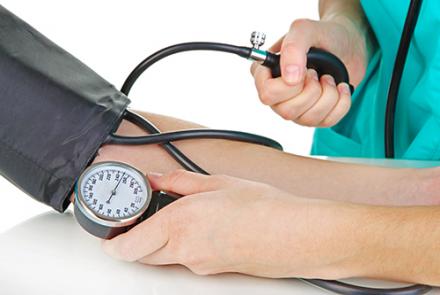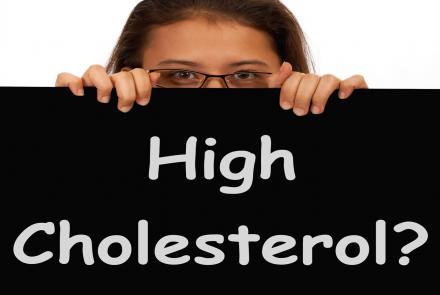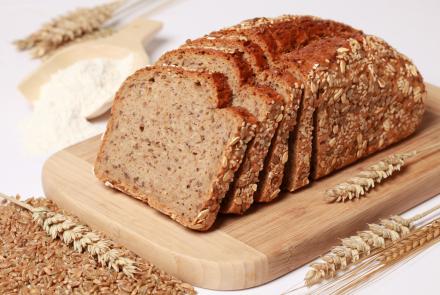
The incidence of heart attack (myocardial infarction) is increasing in India according to NCRB data. It is therefore important that we understand what a heart attack is, the causes and risk factors, symptoms, treatment options.
What is a heart attack? What does the term myocardial infarction mean?
A heart attack, also known as myocardial infarction (MI), occurs when blood can not reach to the heart muscles. This blockage is developed due to plaque buildup within the coronary arteries. When plaque ruptures, it creates a clot that restricts blood flow to the heart muscle.
“Myocardial Infarction” term is derived from Latin and Greek. “Myocardial” means the heart muscle, and “Infarction” means damaged or dead tissue due to blood supply blockage. Timely referral and early treatment are crucial in heart attack as it can cause sudden death.
What causes heart attacks?
Heart attacks are caused by a blockage in the coronary arteries. These can happen because of various reasons:
- Atherosclerosis – It occurs when plaque builds up in arteries. It makes them narrow and reduce the blood flow to the heart. It can result in ischemia, as heart muscles does not get enough blood.
- Coronary artery spasm – Sometimes due to stress, weather or certain medicines, coronary arteries become stiff and tight. That reduces blood flow to the heart leading to a heart attack.
- Plaque rupture – When plaque accumulated in the coronary artery ruptures, it creates clot that blocks the blood flow to the heart muscles. This can cause heart attack.
There are many contributing factors that increase the chances of heart attack, such as:
- High cholesterol - High LDL (low density lipoprotein), known as “bad cholesterol”, can induce plaque formation in arteries.
- Hypertension, Diabetes and, Smoking damage blood vessels and the heart.
- Obesity leads to high blood pressure, high cholesterol and Diabetes, increasing the risk of heart attack.
- Stress and family history also play an important role in developing cardiovascular diseases.
What is the difference between plaque and a clot?
Plaque and clot can cause heart problems. Plaque is a mix of fatty deposits, cholesterol, and calcium-like substances. It creates a thick layer in the coronary arteries that makes them narrow. It obstructs the blood flow to the heart muscle.
Clot is like a jelly made of blood components such as platelets and fibrin. These are also called thrombi. A clot is formed when plaque is ruptured. It creates a blockage of blood flow and causes the death of the tissue.
When a clot is formed in a coronary artery, it is the cause of a Heart Attack. When clots are formed in the veins of legs, they are called Deep Vein Thrombosis or DVTs. Such clots can travel to the lungs and brain causing pulmonary emboli and strokes, respectively.
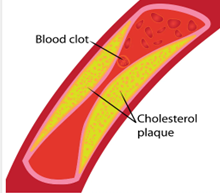
Image – 1 Plaque and blood clot
What are the symptoms and signs of a heart attack?
Heart attack symptoms may vary from person to person and even between men and women.
- Chest pain – It is the most common symptom experienced. Tightness or discomfort in the chest, like a squeezing sensation that lasts a few minutes.. This pain might radiate to the left shoulder, arm, jaw and neck. Pain may be felt in the stomach and be confused as heart burn or acidity. Other causes of non-cardiac chest pain are discussed here.
- Palpitations – Fast heartbeats and fluttering during exercise, anxiety or stress.
- Shortness of breath and difficulty in breathing after any physical activity.
- Fatigue, weakness, dizziness or sweating can occur despite no physical exertion.
- Some individuals may faint suddenly due to inadequate blood flow to the brain.
- Sometimes, there are no symptoms experienced; it is called a “silent attack”.
What are the types of MI?
There are two types of Myocardial Infarction.
- Type 1 – This is the common type of heart attack when arteries are blocked. Blood flow is restricted due to plaque formation and when clot is formed it blocks the blood flow to the heart muscles. Chest pain and difficulty in breathing like signs are experienced.
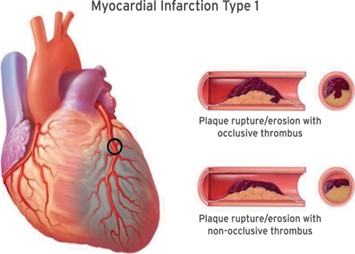
Image 2 – Type 1 myocardial infarction
- Type 2 - It happens when the heart doesn't receive enough oxygen. This can be caused by fast heartbeats, spasms, high blood pressure, and breathing problems. This condition needs special attention as it has a worse outcome than Type 1.

Image 3 - Type 2 myocardial infarction
Based on ST segment elevation on ECG, it is classified into four types:
- ST segment elevation myocardial infarction (STEMI) - It shows significant elevation on an ECG, indicating a complete blockage by a blood clot in the coronary artery.
- Non-ST segment elevation myocardial infarction (NSTEMI) - In this type, the coronary artery is partially blocked.
- Subendocardial myocardial infarction - Damage to the inner layer of the heart muscle due to impaired blood supply.
- Silent myocardial infarction - It occurs when a heart attack damages the heart muscles without causing any noticeable symptoms.
What are silent or mini heart attacks?
A silent heart attack doesn’t show up the usual signs of a heart attack. No symptoms are experienced and people can’t realize they are having a heart attack. Breathing difficulty or fainting can be a warning sign. People might not take a doctor’s advice until the tests show the damage. High blood pressure, high cholesterol, diabetes, obesity and family history are risk factors. So, those who have these risk factors should get regular health checkups and keep track of their heart health.
How is a heart attack diagnosed?
- Review medical history to assess symptoms and risk factors.
- Examination of blood pressure, heart rate, temperature, and respiratory rate.
- Pulse examination – Checking radial, carotid, femoral, and tibial arteries for swelling.
- Blood tests –
- Lipid profile – For measurement of cholesterol and triglyceride to assess cardiovascular risk.
- Cardiac enzymes (e.g., troponin, creatinine kinase)– It measures enzymes released into the bloodstream during a heart attack.
- Assessment of blood sugar levels, especially in people with diabetes.
- C-reactive protein to examine inflammation in the body.
- ECG – It is used to check the heart’s electrical activity to detect any abnormality.
- Angiography – It is an invasive procedure that uses contrast dye and x-rays to visualize coronary arteries and identify blockages or narrowing.
- Cardiac MRI – It provides detailed images of heart and blood vessels to assess damage due to CAD.
- Coronary calcium scoring –It is used to detect coronary artery calcification which is an important marker of Atherosclerosis. It is done through CT scan and is quantified using a scoring system.
- A score of zero - No calcium is seen in the heart and low chances of developing a heart attack.
- A score of 100 to 300 – Moderate plaque deposit which is associated with a high risk of a heart attack over the next 3 to 5 years.
- A score > 300 – There is a high risk of a heart attack.
- Exercise stress test – This test checks your heart rate while you walk on a treadmill to examine how well your heart works under stress.
How is heart attack treated?
The treatment of a heart attack aims to restore blood flow to the heart muscle. Medications and surgical treatments are recommended.
Medications –
- Thrombolytic medicines are used to dissolve blood clots and to restore blood flow to the heart muscles.
- Anti platelet agent such as aspirin is prescribed to prevent blood clot formation and plaque rupture into the arteries.
- Heparin is given to make the blood less sticky and less likely to form clots.
- Statins are used to lower cholesterol levels.
- Beta blockers are used to reduce heart rate and blood pressure. bisoprolol and metoprolol are the most commonly prescribed beta blockers.
- ACE inhibitors such as enalapril, lisinopril, ramipril are used to control the blood pressure.
- For immediate relief of chest pain (angina) nitroglyceride is given sublingually.
Medical procedures –
Coronary angioplasty – In this procedure, a balloon is used to open the blocked arteries. There are two types: plain ballon angioplasty and stent placement.
As shown in image 4, a catheter with a deflated balloon at its tip is guided to the site of the blockage. The balloon is inflated to compress the plaque and widen the artery, restoring blood flow. Sometimes as per patient’s heart condition, stent (a small mesh tube) is inserted into the artery to keep it open and prevent narrowing after the balloon is deflated and removed.
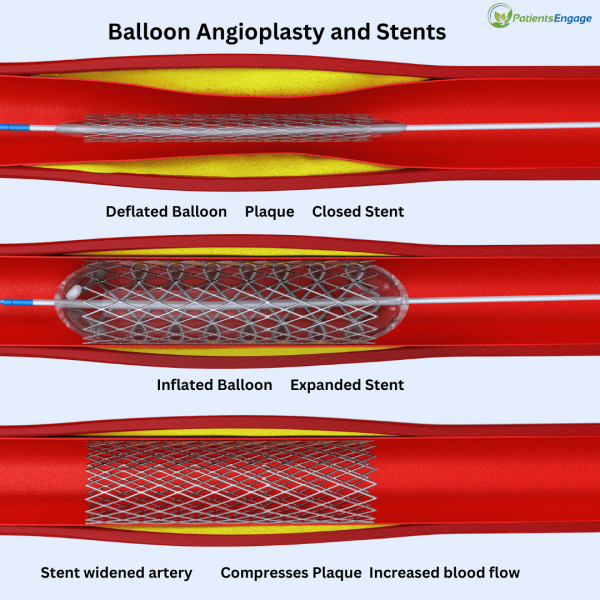
Image 4 – Angioplasty procedure
- Thrombectomy – It removes blood clots from the coronary arteries to restore blood flow.
Surgical treatment –
- Coronary Artery Bypass Grafting (CABG): It is recommended when medicines and angioplasty is not enough. It bypasses blocked arteries using blood vessels from elsewhere in the body to create new route for blood flow to the heart muscle.
Read about a personal experience of CABG at https://www.patientsengage.com/personal-voices/lucky-escape-heart-attack-trauma
What is the recovery time post a heart attack?
As symptoms of a heart attack vary person to person, recovery time also varies. It depends on the severity of a heart attack, the patient’s condition and the damage it did to the heart. It also depends on how well you respond to the treatment and the presence of other chronic conditions. Getting back to the normal activities will take time, for some people it takes a week to months. Cardiac rehabilitation and preventing further complications are very important during this time.
Are there any tests to predict heart attacks?
As discussed earlier, blood tests, ECG, stress tests, and other imaging tests are used to diagnose heart attacks. Below are some biomarker tests used to predict heart attacks in individuals, combined with other clinical assessments:
- High sensitive c-reactive protein – Elevated levels indicate inflammation and increased heart attack risk.
- BNP test and NT-proBNP – Brain natriuretic peptide (BNP) is a protein released by the heart in response to stress and pressure. Elevated levels indicate heart failure and increased heart attack risk.
- Troponin protein is released in the blood during heart muscle damage. It is a strong indicator of a heart attack.
- Myoglobin found in heart and skeletal muscles. Elevated level of it indicates heart muscle damage.
- Homocysteine – Elevated levels of it is linked to increased cardiovascular risk.
How many heart attacks can a person have?
There is a prevalent myth that a human body can survive a minimum of three heart attacks. But there is no exact number of heart attacks a person can have. Having a heart attack damages the heart muscles, heart function and lead to the problems like heart failure, irregular heartbeats and other issues. Adopting lifestyle changes and following preventive steps to reduce the risk of heart disease is very important.
Why have the incidence of heart attacks become more common and occurring earlier?
The increasing number of heart attacks occurring earlier in younger people is because of many reasons. Sedentary lives, eating fast foods, smoking, alcohol consumption habits, stress and mental health issues are more prevalent in younger people nowadays. All these things increase the risk of high blood pressure, high blood sugar, high cholesterol and the risk of getting heart disease.
Can heart attacks be prevented?
Yes, heart attacks can be prevented. As we have discussed risk factors related to heart attacks, addressing them can help avoid heart attacks. Some steps to prevent heart attacks are mentioned below,
- Consume a balanced diet rich in fibre, antioxidants, lean protein, while low in saturated fats, trans fats, sugar and sodium. Include fruits, vegetables, whole grain, legumes, nuts, etc.
- Avoid alcohol and smoking. Don’t hesitate to seek professional help to quit this habit.
- Maintain a healthy weight. Normal Body Mass Index is 18.5 to 24.9 kg/m2. Keeping your BMI within this range is helpful to prevent heart attacks,
- Aim for at least 150 minutes of moderate exercises such as muscle strengthening or aerobic exercises per week. 20 to 30 minutes of cardio a day can be helpful along with that.
- Incorporate heart-healthy habits into your daily routine such as walking instead of driving short distance, taking stairs instead of the lift, walking in house for every 30 minutes to avoid prolonged sitting. It is good to take breaks to stand, stretch and move around during office hours also.
- Get 8 hours of quality sleep and maintain your sleep schedule.
- Practice stress reduction activities such as deep breathing, meditation, and yoga for relaxation.
- Regularly monitor blood sugar and blood pressure to avoid risks. If you are diabetic or hypertensive follow your medications regularly and be aware of the signs and symptoms to seek emergency care.
- Get a full medical check-up done biannually.
- Stay informed and share knowledge about the symptoms and promote heart-healthy lifestyle.
By Dr. Lavleen Gaur and Dr. Shital Patel
References
- https://www.cdc.gov/heartdisease/heart_attack.htm
- https://www.ncbi.nlm.nih.gov/books/NBK537076/
- https://my.clevelandclinic.org/health/diseases/16818-heart-attack-myoca…
- https://www.mayoclinic.org/diseases-conditions/heart-attack/symptoms-ca…
- https://www.hopkinsmedicine.org/health/conditions-and-diseases/thrombos…
- https://pediaa.com/difference-between-atherosclerosis-and-thrombosis/
- Image 1 Plaque and clot- https://www.vectorstock.com/royalty-free-vector/blood-clot-and-choleste…
- Image 2 and 3, MI Types 1 and https://www.ahajournals.org/doi/10.1161/CIR.0000000000000617
- https://my.clevelandclinic.org/health/articles/17055-heart-attack-recov…
- https://www.nhs.uk/conditions/heart-attack/recovery/
- https://www.texasheart.org/heart-health/heart-information-center/topics…
- https://www.msdmanuals.com/en-nz/professional/cardiovascular-disorders/…

